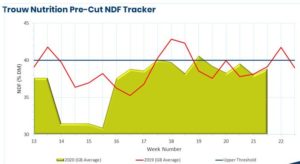Compared to last week’s average of 63kg DM/ha/day, this week’s grass growth has seen a sharp decline average at 47kg DM/ha/day. The biggest decline in grass growth was seen in the Southern regions of -24kg DM/ha/day. The East saw the highest growth of 55kg DM/ha/day while the South East and Scotland saw the poorest growth of 43kg DM/ha/day.
Potential MYFG has increased, averaging M+16.33 litres/day, which is greater than last year’s average for this week of M+13.70 litres per day and the 6-year average of M+13.31 litres/day. This increase can be a result of the 2.04kg/day increase in potential grass DM intake. The highest MYFG figures averaging M+23.2 litres/day was seen in the East, while the lowest figure averaging M+9.5litres/day in the North East and Yorkshire. Consideration should be given when interpreting these results as these regions (North East and Yorkshire) only accounted for 12.2% of the data set each.
Butterfat Factors
Reduced butterfats are common in the spring months due to the lush grass, which is high in oil and sugars, and low in fibre. The rumen microbes change so the VFAs that they produce drive yield rather than milk fat production.
The risk of butterfat depression is high, with a low fibre index being reported at 165. This lower fibre content means that cows are ruminating less and produce less salivary buffers. The Acid Load and RFC are high which further increase the risk of acidosis and therefore risk of butterfat depression through changing in pH.
Prevention is always the best option to help reduce this risk. Providing straw and fibrous silage around milking as a buffer can increase the production of saliva which can help mitigate this risk. In the diet, the addition of buffers and yeast culture can also help- to resist the drop in pH and to stimulate the growth of favourable microbial populations.
Heat Stress
With ambient temperatures forecasted in the coming weeks, which may increase the risk of heat stress in cattle. Ensure clean, fresh drinking water is always available and access to shade can help mitigate the risks associated with heat stress!

Pre-Cut NDF Development
Samples continue to be ideal for optimizing first cut silage quality, at an average of 38.89%. As June quickly approaches and with favourable conditions, many farmers have taken their first cuts. For those who have not, opportunities still remain.
Source: Trouw Nutrition GB

